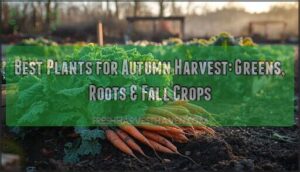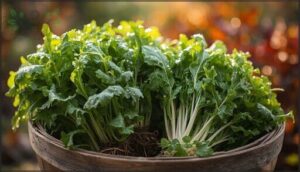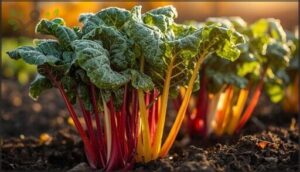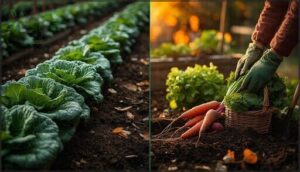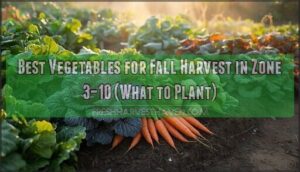This site is supported by our readers. We may earn a commission, at no cost to you, if you purchase through links.
When frost threatens most garden plants, a select group shrugs off the cold and delivers their best flavors. These autumn champions don’t just survive cool weather—they thrive in it, converting near-freezing nights into sugars that make carrots taste like candy and kale shed its bitterness.
While summer gardeners pack up their tools, fall growers are just hitting their stride, planting crops that need less water, face fewer pests, and often outlast the first snow. The secret lies in choosing the best plants for autumn harvest, varieties bred to flourish when temperatures drop and daylight fades.
With the right selections and simple season-extension tricks, your garden can keep producing fresh greens, sweet roots, and hearty brassicas well into winter.
Table Of Contents
Key Takeaways
- Fall gardening often proves easier than spring planting because cool-season crops face fewer pests, need less water, and develop sweeter flavors after frost converts starches into sugars.
- Leafy greens like spinach, kale, and arugula thrive in autumn temperatures, with many varieties tolerating frost down to 15°F while delivering quick harvests within 3-8 weeks of planting.
- Root vegetables such as carrots, beets, and turnips actually improve in flavor after exposure to cold weather, making them ideal candidates for extended harvest well into winter with proper mulching.
- Simple season-extension tools like cold frames and row covers can add 4-8 weeks to your growing season, protecting crops through light frosts and allowing you to harvest fresh vegetables when grocery prices peak.
Why Plant for an Autumn Harvest?
Fall gardening offers more than just a second chance at fresh vegetables—it can actually be easier and more rewarding than spring planting. Cool-season crops thrive in autumn’s milder temperatures, facing fewer pest problems while producing sweeter, more flavorful harvests.
By planning your fall garden strategically, you’ll extend your growing season well into winter and enjoy homegrown produce when grocery store prices climb.
Benefits of Fall Vegetable Gardening
When you start fall vegetable gardening, you’ll discover benefits that truly extend beyond summer’s bounty. Your extended harvest brings improved flavor as cooler weather sweetens carrots and greens, while reduced pests mean less damage to your crops.
You’ll also enjoy water conservation since evaporation drops considerably, and your soil health improves through smart fall garden preparation.
Harvesting vegetables in fall becomes remarkably rewarding, making fall planting a smart strategy for extending the growing season. Fall gardening also enhances mental and physical health.
Advantages of Cool-Season Crops
Cool-season crops offer frost tolerance, allowing vegetables like kale and spinach to survive temperatures as low as −15°C. Their nutritional benefits are notable—carrots, for instance, convert starch to sugar after a frost, enhancing their sweetness.
You’ll appreciate the water efficiency of these crops, as fall rains reduce the need for irrigation. Additionally, easy cultivation through direct sowing simplifies fall vegetable gardening, eliminating transplant hassles.
These crops are also less prone to heat stress, making them ideal for mild temperatures.
Extending Your Harvest Season
Beyond frost tolerance, you can extend your harvest season well into winter using simple season extension structures. Cold frames add six to eight weeks of fall harvest, while mini hoop tunnels push back frost by four to six weeks.
Late-season planting of cool-season crops like spinach and carrots maximizes your fall crops production. Microclimate utilization—such as south-facing slopes—further delays frost damage, keeping you harvesting fall vegetables longer than traditional schedules allow.
Top Leafy Greens for Autumn Harvest
Leafy greens are some of the easiest crops to grow in autumn, thriving when temperatures drop and other plants slow down. They’re packed with nutrients, mature quickly, and many actually taste better after a light frost sweetens their leaves.
Here are four reliable leafy greens that will give you a steady harvest well into the cooler months.
Spinach – Fast-Growing and Frost Tolerant
Spinach thrives when temperatures drop, making it one of the most reliable leafy greens for your fall harvest. You’ll appreciate its ability to withstand frost and cold snaps that would damage less hardy vegetables, and its quick maturity means you can enjoy fresh greens within weeks of planting.
- Frost-tolerant spinach survives temperatures as low as 15°F to 20°F, outlasting many other cool-season vegetables
- Autumn spinach varieties like ‘Matador’ and ‘Verdil’ offer enhanced cold resistance for extended harvesting
- Spinach nutrition delivers 23 calories, 3g protein, and abundant vitamins A, C, and K per 100g serving
- Spinach cultivation requires planting 6-8 weeks before first frost with consistent soil moisture
- Harvesting spinach involves clipping mature outer leaves while allowing inner growth to continue producing
Kale – Nutrient-Dense and Cold Hardy
Kale stands out among fall crops as a leafy green that actually gets better after frost. Its cold tolerance is outstanding—this hardy vegetable thrives in freezing temperatures and survives well into late autumn, accumulating natural sugars that improve its culinary quality.
Kale nutrition is impressive, delivering over 600% of your daily vitamin K per cup, plus calcium, iron, and vitamin C.
For an autumn yield, plant about 60 days before frost and maintain consistent soil moisture through September and October to boost your fall harvest.
Arugula and Mizuna – Quick-Maturing Salad Greens
For fast salad greens, arugula and mizuna are your go-to leafy greens. Both reach harvest size in just 3 to 4 weeks, perfect for a quick fall harvest. Their frost tolerance is excellent, with mizuna handling brief freezes and arugula growing through light frosts.
You’ll appreciate their nutritional profile—rich in vitamins A, K, and C. Growing conditions are simple: well-draining soil, consistent moisture, and partial shade work beautifully.
Swiss Chard – Colorful and Resilient
Swiss chard stands out among fall harvest greens for its striking color varieties—from ruby red to bright yellow stems—and impressive cold tolerance down to 15°F.
You’ll harvest weekly once plants establish, with nutritional benefits peaking after frost sweetens the leaves.
Disease resistance varies by cultivar, but proper spacing and fall planting timing help produce strong yields of this resilient Beta vulgaris through late autumn.
Best Root Vegetables for Fall Picking
Root vegetables thrive in the cooler days of fall, bringing flavor and color to your harvest. These crops are sturdy, adaptable, and often sweeter after a touch of frost.
Here’s what to look for when planning your best fall pickings.
Carrots – Sweet Flavor After Frost
When cold nights arrive, carrots (Daucus carota) transform into frost-sweetened root vegetables through sugar conversion—an antifreeze mechanism that creates a candy-like flavor. Cold acclimation triggers this striking change, making fall crops tastier than summer harvests. To get the most sweetness:
Carrots transform after frost, converting starch to sugar through cold acclimation—a natural antifreeze that makes fall harvests sweeter than summer crops
- Plant mid-summer for best harvest after first frost
- Leave in ground post-frost for peak sugar accumulation
- Mulch beds for storage benefits and extended picking into winter
Beets – Cold-Tolerant and Versatile
Beets (Beta vulgaris) rank among the most cold-tolerant root vegetables, surviving frost and near-freezing conditions while developing sweeter flavors. You’ll harvest these adaptable autumn vegetables in 50 to 70 days, with both roots and nutrient-rich greens ready for your table.
Climate adaptability makes beets reliable fall crops across zones, with varieties like ‘Detroit Dark Red’ and ‘Lutz Green Leaf’ excelling in cooler temperatures.
| Feature | Details |
|---|---|
| Cold Tolerance | Semi-hardy; survives 28-32°F light frost |
| Nutritional Benefits | 58.5 kcal, 442 mg potassium, 148 mcg folate per cup |
| Autumn Growth | Plant 6-8 weeks before first frost; matures slowly in cool weather |
| Culinary Uses | Roast, boil, or eat raw; sauté greens with herbs |
Turnips and Daikon Radish – Rapid Maturity
Turnips and daikon radish mature in just 40 to 63 days, making them ideal fall crops when you’re racing against the first frost. Autumn sowing from July through September yields sweeter root vegetables after exposure to light cold, thanks to their impressive cold hardiness.
Sequential planting every two weeks extends your harvest, and you’ll enjoy nutritional benefits from both roots and edible greens before winter arrives.
Green Onions – Hardy and Easy to Grow
Green onions (Allium cepa) stand out among cool-season vegetables for their remarkable cold tolerance, surviving soil temperatures down to 21°F. You’ll harvest in just 60 to 70 days, yielding about 1 to 1.5 pounds per linear foot.
Their disease resistance and minimal water requirements make growing vegetables like these straightforward, while nutritional benefits include vitamin C and K for your fall harvest table.
Classic Fall Crops for Autumn Abundance
When you think of autumn harvests, a few signature crops probably come to mind right away. These classic vegetables have long growing seasons and thrive in the cooler temperatures that fall brings.
Let’s look at the heavy hitters that define autumn abundance in the garden.
Pumpkins and Winter Squash – Long-Season Staples
Growing pumpkin varieties and winter squash for autumn harvest takes patience, since maturity ranges from 70 to 120 days. Plant by early July for Halloween harvesting vegetables.
These fall crops demand at least 50 square feet of planting space per hill, well-drained soil, and a soil pH between 6.2 and 6.5.
Squash nutrition—particularly vitamin A and fiber—makes these vegetable varieties worth the wait come fall harvest.
Cabbage and Brussels Sprouts – Frost-Resistant Brassicas
Unlike pumpkins and squash, Brassica oleracea varieties like cabbage (var capitata) and Brussels sprouts (var gemmifera) excel with frost tolerance. You’ll want to know their nutritional comparison and yield maximization strategies:
- Cabbage withstands temperatures down to 20°F, perfect for fall crops
- Brussels sprouts contain 164% more protein than cabbage per 100g
- Genetic adaptations (BrCRG1-7 genes) boost cold resistance
- Proper crop management timing increases harvest quality considerably
Broccoli and Cauliflower – Cool-Weather Champions
Broccoli (Brassica oleracea var. italica) and cauliflower (Brassica oleracea var. botrytis) are true cool-season vegetables that reward your patience with outstanding nutritional benefits.
Broccoli matures in 54 to 68 days, tolerating temperatures down to 20°F once established, while cauliflower prefers slightly warmer conditions around 61°F to 64°F. Both thrive in well-drained soil with pH 6.0 to 7.5.
They deliver impressive yields when you harvest compact broccoli crowns and tight, white cauliflower curds before flowering begins.
Bok Choy and Collards – Reliable Greens
For maximum success with Bok Choy and Collards, you’ll appreciate their distinct advantages as leafy greens. Bok choy growth accelerates in 45 days within 45°F to 75°F, thriving as a cool-season vegetable rich in vitamins C and K.
Collard cold hardiness surpasses most fall vegetables, surviving 10°F to 15°F while delivering great nutritional benefits.
Both offer varied culinary uses and respond well to strategic late-summer planting strategies.
Tips for a Successful Autumn Harvest
Getting your fall garden off the ground takes more than just choosing the right crops. You’ll need to pay attention to timing, soil prep, and a few simple tricks that help seeds sprout and plants thrive when temperatures start to drop.
Let’s walk through the essentials that’ll set you up for a bountiful autumn harvest.
Timing Your Plantings and Frost Protection
Calculating your first frost date and working backward from each crop’s maturity date sets the foundation for autumn success. Soil temperature monitoring helps you avoid delayed planting problems, while succession planting every week or two spreads out your harvest.
For growing season extension and protecting from frost, use row covers at the right time—they’ll give you 4–8°F of protection and add weeks to your picking window.
Choosing The Right Varieties
When choosing fall crops, you need varieties bred for cold hardiness and disease resistance. ‘Winterbor’ kale survives down to -10°F, while ‘Tyee’ spinach resists downy mildew and thrives at 20°F.
For succession planting, pick fast-maturing options like arugula and radishes that mature in under 30 days.
Yield performance matters too—’Red Russian’ kale and ‘Bright Lights’ chard deliver reliable harvests even after repeated frosts.
Soil Preparation and Raised Bed Strategies
Nutrient testing after harvest reveals phosphorus and potassium gaps in over 40% of fall plots, so you’ll want to address deficiencies early. Mixing 2 to 4 inches of compost into the top 8–12 inches boosts organic matter by 18% in one season.
Raised beds with cedar or composite materials last around 12 years and drain 60% faster than ground-level plots, reducing waterlogging during autumn rains.
Watering, Mulching, and Seed Starting Techniques
Watering frequency drops in fall, so aim for deep sessions once or twice weekly rather than daily spritzes. Root watering with soaker hoses keeps foliage dry and improves soil retention. Mulch benefits include moisture control and weed suppression.
For seed timing, start brassicas indoors mid-August through early October in milder zones, then harden off seedlings when soil conditions cool to 50–60°F at night.
Frequently Asked Questions (FAQs)
Can I grow autumn crops in containers?
You can absolutely grow fall vegetables in containers—in fact, over 30 cool-season vegetables thrive in pots, from leafy greens to root crops, making container gardens ideal for autumn harvests.
How do I protect plants from early frost?
Cover your plants with frost fabric or blankets, securing them to the ground. Water lightly in late afternoon, apply mulch around bases, and position tender plants near heat-retaining structures for microclimate protection.
What tools are best for fall harvesting?
When harvesting season arrives, you’ll need sharp hand pruners, harvest baskets, and garden knives like the Hori Hori for cutting stems and digging root crops.
Protective equipment, including durable gloves, prevents cuts during fall harvesting.
Are autumn vegetables more nutritious than summer ones?
Many fall vegetables pack serious nutritional punch. Kale and spinach are among the most nutrient-dense options, while seasonal vitamin C variations show that autumn harvest timing truly affects dietary impacts from cool-season vegetables.
How do I store harvested fall vegetables?
You’ll want to focus on humidity control and temperature when storing fall vegetables.
Root cellars work well for carrots and beets, while freezing techniques and canning methods help extend the harvest season for garden vegetables.
Conclusion
Think of your autumn garden as a bridge between seasons—steady, reliable, built to carry you through when summer’s abundance fades. The best plants for autumn harvest don’t demand flawlessness; they reward simple preparation with sweeter flavors and tougher constitutions.
By choosing cold-hardy varieties and protecting them from hard frosts, you’re not just extending your growing season. You’re creating a safety net of fresh food when grocery prices climb and winter settles in.

